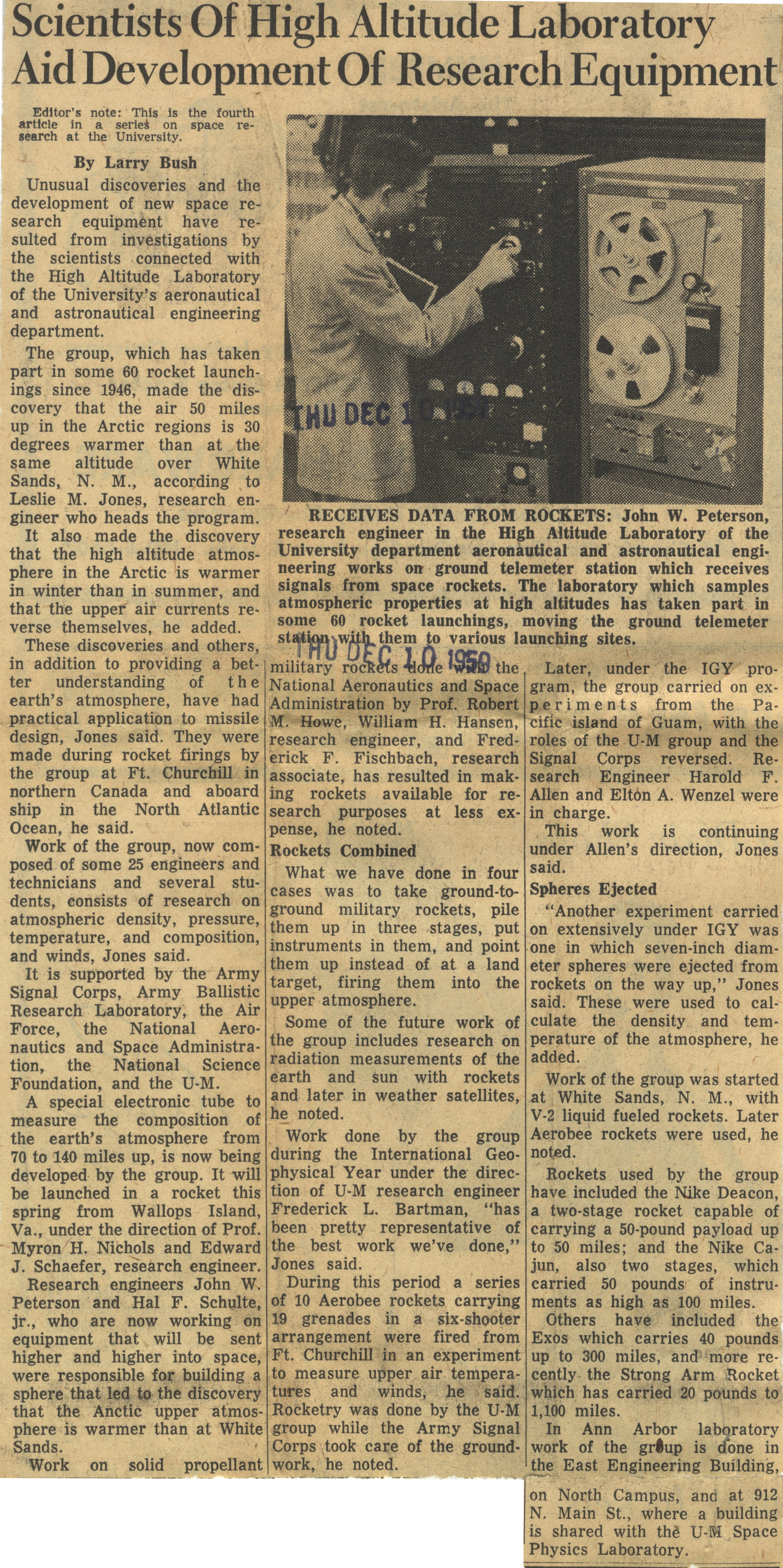Scientists Of High Altitude Laboratory Aid Development Of Research Equipment

Scientists Of High Altitude Laboratory Aid Development Of Research Equipment
(Editor's note: This is the fourth article in a series on space research at the University.)
By Larry Bush
Unusual discoveries and the development of new space research equipment have resulted from investigations by the scientists connected with the High Altitude Laboratory of the University’s aeronautical and astronautical engineering department.
The group, which has taken part in some 60 rocket launchings since 1946, made the discovery that the air 50 miles up in the Arctic regions is 30 degrees warmer than at the same altitude over White Sands, N.M., according to Leslie M. Jones, research engineer who heads the program.
It also made the discovery that the high altitude atmosphere in the Arctic is warmer in winter than in summer, and that the upper air currents reverse themselves, he added.
These discoveries and others, in addition to providing a better understanding of the earth’s atmosphere, have had practical application to missile design, Jones said. They were made during rocket firings by the group at Ft. Churchill in northern Canada and aboard ship in the North Atlantic Ocean, he said.
Work of the group, now composed of some 25 engineers and technicians and several students, consists of research on atmospheric density, pressure, temperature, and composition, and winds, Jones said.
It is supported by the Army Signal Corps, Army Ballistic Research Laboratory, the Air Force, the National Aeronautics and Space Administration, the National Science Foundation, and the U-M.
A special electronic tube to measure the composition of the earth’s atmosphere from 70 to 140 miles up, is now being developed by the group. It will be launched in a rocket this spring from Wallops Island, Va., under the direction of Prof. Myron H. Nichols and Edward J. Schaefer, research engineer.
Research engineers John W. Peterson and Hal F. Schulte, jr., who are now working on equipment that will be sent higher and higher into space, were responsible for building a sphere that led to the discovery that the Arctic upper atmosphere is warmer than at White Sands.
Work on solid propellant military rockets done with the National Aeronautics and Space Administration by Prof. Robert M. Howe, William H. Hansen, research engineer, and Frederick F. Fischbach, research associate, has resulted in making rockets available for research purposes at less expense, he noted.
Rockets Combined
What we have done in four cases was to take ground-to-ground military rockets, pile them up in three stages, put instruments in them, and point them up instead of at a land target, firing them into the upper atmosphere.
Some of the future work of the group includes research on radiation measurements of the earth and sun with rockets and later in weather satellites, he noted.
Work done by the group during the International Geophysical Year under the direction of U-M research engineer Frederick L. Bartman, ‘‘has been pretty representative of the best work we’ve done,” Jones said.
During this period a series of 10 Aerobee rockets carrying 19 grenades in a six-shooter arrangement were fired from Ft. Churchill in an experiment to measure upper air temperatures and winds, he said. Rocketry was done by the U-M group while the Army Signal Corps took care of the groundwork, he noted.
Later, under the IGY program, the group carried on experiments from the Pacific island of Guam, with the roles of the U-M group and the Signal Corps reversed. Research Engineer Harold F. Allen and Elton A. Wenzel were in charge.
This work is continuing under Allen’s direction, Jones said.
Spheres Ejected
‘‘Another experiment carried on extensively under IGY was one in which seven-inch diameter spheres were ejected from rockets on the way up,” Jones said. These were used to calculate the density and temperature of the atmosphere, he added.
Work of the group was started at White Sands, N.M., with V-2 liquid fueled rockets. Later Aerobee rockets were used, he noted.
Rockets used by the group have included the Nike Deacon, a two-stage rocket capable of carrying a 50-pound payload up to 50 miles; and the Nike Cajun, also two stages, which carried 50 pounds of instruments as high as 100 miles.
Others have included the Exos which carries 40 pounds up to 300 miles, and more recently the Strong Arm Rocket which has carried 20 pounds to 1,100 miles.
In Ann Arbor laboratory work of the group is done in the East Engineering Building, on North Campus, and at 912 N. Main St., where a building is shared with the U-M Space Physics Laboratory.
[image]: RECEIVES DATA FROM ROCKETS: John W. Peterson, research engineer in the High Altitude Laboratory of the University department aeronautical and astronautical engineering works on ground telemeter station which receives signals from space rockets. The laboratory which samples atmospheric properties at high altitudes has taken part in some 60 rocket launchings, moving the ground telemeter station with them to various launching sites.
Article
Subjects
Larry Bush
University of Michigan - High Altitude Laboratory
University of Michigan - Research
University of Michigan - Aeronautical & Astronomical Engineering Department
Rocketry
University of Michigan - Faculty & Staff
U. S. Army Signal Corps
Army Ballistic Research Laboratories
U.S. Air Force
National Aeronautics and Space Administration (NASA)
International Science Foundation
International Geophysical Year
Aerobee Rockets
University of Michigan - Space Physics Research Laboratory
Has Photo
Old News
Ann Arbor News
Leslie M. Jones
Myron H. Nichols
Edward J. Schaefer
John W. Peterson
Hal F. Schulte Jr
Robert M. Howe
William H. Hansen
Frederick F. Fischbach
Fred L. Bartman
Harold F. Allen
Elton A. Wenzel
Duane Scheel
912 N. Main St